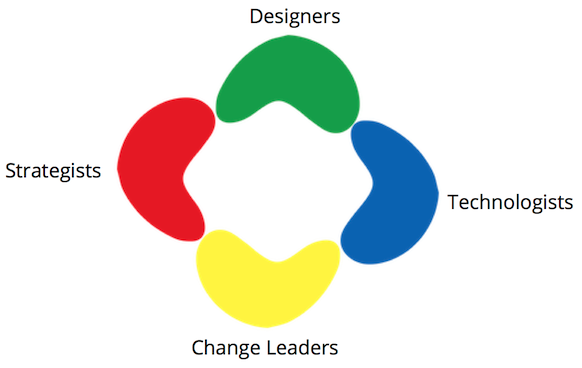
Geeks, Freaks and MBAs Play Innovation Jazz
Have you noticed the job postings? Design companies want developers. Technology specialists are competing for designers and big business strategy firms are gobbling up entire agencies and boutiques whole. What’s going on with this wholesale rush to stitch together firms from tribes with wildly different professional disposition?
Something big is brewing, but to understand the change we need to look back at the way technology driven innovation has been done for the last decade. Emerging from the dot.com era, firms specialized in the new crafts of digital Strategy, Design, Technology and Change Leadership. It’s been common to see firms strung together like a series of solo performers at a concert.

Waterfall – Isolated Soloists Playing From Fixed Scores
In the most inflexible versions of this Waterfall design model, each team uses rigid processes with few outside inputs from outside and little tolerance for change. Each solo performer playing exactly what’s on the page delivered a long list of spectacular product failures.
Things Get (A Little) Better
Enter agile. With its iterative cycles of development and collaborative teams, went from being a countercultural rebellion to being business as usual for most modern software development shops. There was a dirty secret though. All this iterative goodness was embedded in a broader process that remained largely waterfall.

Water-Scrum-Fall. Agile Embedded in Waterfall
In recent years, Agile has spread. Designers leverage lightweight artifacts, guerilla testing and more frequent business collaboration. Agile for Strategy and Change Leadership isn’t far behind. This is good news, but as long as it is done as a series of independent activities, we have actually created a scrum-scrum-scrum-scrum-fall. Each performer ups their game, but we continue to be limited by the underlying sequential nature of our performance.

Still Soloing (but better) – Scrum Scrum Scrum Scrum Fall
Why Geeks, Freaks and MBAs?
So let’s go back to our original question. Why are these specialist firms hiring talent from the other domains? Is it just to bolt them together in their own proprietary scrum-scrum-scrum-scrum-fall? That actually might make sense. It’s a classic vertical integration business strategy, the kind American automotive companies leveraged in the 20th Century.
But wait … that didn’t work out so well. As competitive pressures and product innovation increased, auto manufacturers divested their vertically integrated subsidiaries. So why this 21st Century rush to merge geeks, freaks, and MBAs? We need another revolution for this to make sense. Let’s look at scrum-scrum-scrum-scrum-fall again. Each team has increased the number and frequency of inputs they get. They are like performers on stage, responding to requests from the audience.
The trouble is with the isolation of the teams, it is likely that only a portion of the discovered opportunities voiced will actually be heard and acted on. Teams will hear only what they are passionate about. Designers will immediately catch the odd comment about a difficult point of interaction, but may entirely miss the implications a discussion might have on a technology choice. The same is true for any of these domains.
Oh sure, a teams could record insights for later action by others, but that will often be too late to capture the full value of the discovery. That isn’t a viable strategy.
Performing Innovation Jazz
What’s needed is a team that has the entire different DNA in one place and a way to act on multiple types of insight throughout the product lifecycle. A team needs to look like this.

This set of isolated teams is at a dead end. This team plays together, replacing individual soloists with a group that merges its performance. It’s product innovation jazz. Now when ideas come in, they can be heard and acted on.

Product Innovation Jazz – Everyone Together From Start to End
This explanation makes sense as to why industry specialists are bringing in new types of talent. If collaborative innovation jazz takes hold, all these skills will need to be in the room to optimize the value of learning and the creative response to discovered opportunities.
This is a big change. If multi-skilled collaborative strategies pay dividends, delivering more compelling products to market faster, it’s going to be a hard road for those organizations that continue with old style solo performances.
Disclaimer: The statements and opinions expressed in this article are those of the author(s) and do not necessarily reflect the positions of Thoughtworks.














